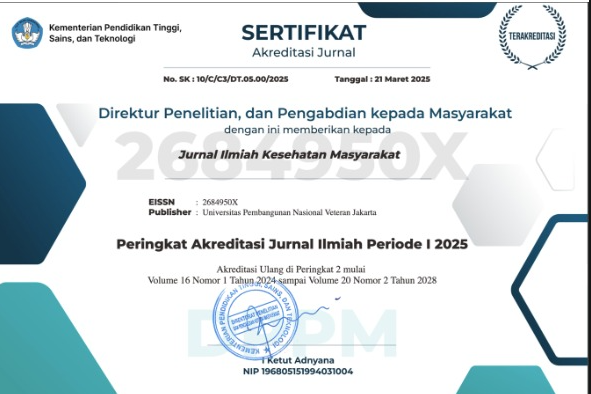Local Wisdom Education for Better Toddler Nutrition: Preventing Stunting in Tulungagung
Abstract
Abstract
Introduction: The prevalence of stunting in Indonesia is still high. Stunting research is important because stunting is a serious public health problem. Healthy feeding is expected to prevent stunting, obesity, and malnutrition. This study aims to examine the level of influence of local wisdom-based health education with booklet media effective in improving toddler nutrition parenting.
Methods: The study uses a quasi-experimental design to see if local wisdom-based health education can improve toddler nutrition parenting practices. Mothers in the intervention group will receive health education and booklets, while mothers in the control group will not. The researchers will then compare the two groups to see if there is a difference in their toddler nutrition parenting practices.
Results: Wilcoxon test shows health education improved toddler nutrition parenting practices (p-value=0.00). The paired t-test result with a p-value of 0.047 further confirms the findings of the Wilcoxon test. Research shows that health education based on local wisdom with booklet media is effective in improving the nutritional parenting style of toddlers. This health education can help prevent stunting in toddlers.
Conclusion: The use of local wisdom-based health education books can be considered as a medium to improve toddler nutritional practices and prevent stunting.
Keywords: Booklet, Local wisdom, Parenting, Prevalence of stunting, Toddler nutrition
Abstrak
Latar Belakang: Prevalensi stunting di Indonesia masih tinggi. Penelitian stunting penting karena stunting merupakan masalah kesehatan masyarakat yang serius. Pemberian makanan sehat diharapkan dapat mencegah stunting, obesitas, dan gizi buruk. Penelitian ini bertujuan untuk menguji tingkat pengaruh pendidikan kesehatan berbasis kearifan lokal dengan media booklet yang efektif dalam meningkatkan pola asuh gizi balita.
Metode: Penelitian ini menggunakan desain quasi eksperimental untuk melihat apakah pendidikan kesehatan berbasis kearifan lokal dapat meningkatkan praktik pengasuhan gizi balita. Ibu pada kelompok intervensi akan mendapatkan pendidikan kesehatan dan booklet, sedangkan ibu pada kelompok kontrol tidak. Peneliti membandingkan kedua kelompok untuk melihat apakah ada perbedaan dalam praktik pengasuhan gizi balita.
Hasil: Uji Wilcoxon menunjukkan pendidikan kesehatan meningkatkan praktik pengasuhan gizi balita (p-value=0,00). Hal ini menunjukkan bahwa kelompok intervensi yang mendapat pendidikan kesehatan mengalami peningkatan pola asuh gizi balita dibandingkan kelompok kontrol yang tidak mendapat intervensi. Hasil uji t berpasangan dengan nilai p 0,047 memperkuat temuan uji Wilcoxon. Penelitian menunjukkan bahwa pendidikan kesehatan berbasis kearifan lokal dengan media booklet efektif dalam meningkatkan pola asuh gizi balita. Pendidikan kesehatan ini dapat membantu mencegah stunting pada balita.
Kesimpulan: Penggunaan buku edukasi kesehatan berbasis kearifan lokal dapat dipertimbangkan sebagai media untuk meningkatkan praktik gizi balita dan mencegah stunting.
Kata kunci: Booklet, Gaya pengasuhan, Kearifan lokal, Nutrisi balita, Prevalensi stunting
References
Nassreddine LM, Naja FA, Hwalla NC, Ali HI, Mohamad MN, Fatima F Al, et al. Total Usual Nutrient Intakes and Nutritional Status of United Arab Emirates Children (<4 Years): Findings from the Feeding Infants and Toddlers Study (FITS) 2021. Curr Dev Nutr [Internet]. 2022;6(5):nzac080. Available from: https://doi.org/10.1093/cdn/nzac080.
Huriah T, Lestari Y, Sudyasih T, Sutantri S, Edi Susyanto B. Pendidikan Ibu Berbasis Masyarakat (PIBM) dalam Meningkatkan Pengetahuan dan Sikap Pemenuhan Gizi Balita Stunting. J SOLMA. 2020;9(2):400–10.
Annur CM. Daftar Prevalensi Balita Stunting di Indonesia pada 2022, Provinsi Mana Teratas? [Internet]. databoks.katadata.co.id. 2023 [cited 2023 Jul 12]. p. 1. Available from: https://databoks.katadata.co.id/datapublish/2023/02/02/daftar-prevalensi-balita-stunting-di-indonesia-pada-2022-provinsi-mana-teratas
Shodikin AA, Mutalazimah M, Muwakhidah M, Mardiyati NL. Tingkat Pendidikan Ibu Dan Pola Asuh Gizi Hubungannya Dengan Kejadian Stunting Pada Balita Usia 24-59 Bulan. J Nutr Coll. 2023;12(1):33–41.
Pai UA, Chandrasekhar P, Carvalho RS, Kumar S. The role of nutrition in immunity in infants and toddlers: An expert panel opinion. Clin Epidemiol Glob Heal [Internet]. 2018;6(4):155–9. Available from: https://doi.org/10.1016/j.cegh.2017.11.004
Wei Kee Tan V, Lim AJY, McCrickerd K, Forde CG. Sensory profiles and mothers’ expectations and beliefs about age appropriate snacks for infants and toddlers in Singapore. Food Qual Prefer. 2022;97(August 2021).
Klerks M, Román S, Juan Francisco Haro-Vicente, Bernal MJ, Sanchez-Siles LM. Healthier and more natural reformulated baby food pouches: Will toddlers and their parents sensory accept them? Food Qual Prefer. 2022;99(July 2021).
Wojcicki JM, Tsuchiya KJ, Murakami K, Ishikuro M, Obaru T, Morisaki N. Limited consumption of 100% fruit juices and sugar sweetened beverages in Japanese toddler and preschool children. Prev Med Reports [Internet]. 2021;23:101409. Available from: https://doi.org/10.1016/j.pmedr.2021.101409.
Hurley KM, Pepper MR, Candelaria M, Wang Y, Caulfield LE, Latta L, et al. Systematic development and validation of a theory-based questionnaire to assess toddler feeding. J Nutr [Internet]. 2013;143(12):2044–9. Available from: https://doi.org/10.3945/jn.113.179846.
Bronte-Tinkew J, Zaslow M, Capps R, Horowitz A, McNamara M. Food insecurity works through depression, parenting, and infant feeding to influence overweight and health in toddlers. J Nutr [Internet]. 2007;137(9):2160–5. Available from: https://doi.org/10.1093/jn/137.9.2160
Roess AA, Jacquier EF, Catellier DJ, Carvalho R, Lutes AC, Anater AS, et al. Food consumption patterns of infants and toddlers: Findings from the feeding infants and toddlers study (FITS) 2016. J Nutr [Internet]. 2018;148(9):1525S-1535S. Available from: https://doi.org/10.1093/jn/nxy171
Eldridge AL, Catellier DJ, Hampton JC, Dwyer JT, Bailey RL. Trends in mean nutrient intakes of US infants, toddlers, and young children from 3 Feeding Infants and Toddlers Studies (FITS). J Nutr [Internet]. 2019;149(7):1230–7. Available from: https://doi.org/10.1093/jn/nxz054
Ballarotto G, Murray L, Bozicevic L, Marzilli E, Cerniglia L, Cimino S, et al. Parental sensitivity to toddler’s need for autonomy: An empirical study on mother-toddler and father-toddler interactions during feeding and play. Infant Behav Dev [Internet]. 2023;73(October):101892. Available from: https://doi.org/10.1016/j.infbeh.2023.101892.
Johnson SL, Moding KJ, Grimm KJ, Flesher AE, Bakke AJ, Hayes JE. Infant and Toddler Responses to Bitter-Tasting Novel Vegetables: Findings from the Good Tastes Study. J Nutr [Internet]. 2021;151(10):3240–52. Available from: https://doi.org/10.1093/jn/nxab198.
Gordon HS, Pugach O, Solanki P, Gopal RK. A brief pre-visit educational video improved patient engagement after telehealth visits; results from a randomized controlled trial. PEC Innov [Internet]. 2022;1(March):100080. Available from: https://doi.org/10.1016/j.pecinn.2022.100080.
Akbar KF. Pengaruh Pendidikan Kesehatan Pada Ibu Yang Memiliki Balita Gizi Kurang. Nurs Insid Community. 2021;3(April):55–60.
Asnidawati A, Ramdhan S. Hambatan Pemberian ASI Eksklusif Pada Bayi Usia 0-6 Bulan. J Ilm Kesehat Sandi Husada. 2021;10(1):156–62.
Merita M, Chandra F, Nurbintang G. Upaya Peningkatkan Pengetahuan Tentang Pola Asuh Gizi Balita di Desa Pulau Melako. E-Dimas J Pengabdi Kpd Masy. 2021;12(1):173–7.









.jpg)








